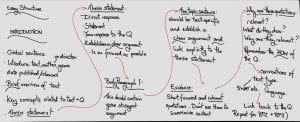Thought you might like this resource, just to remind you of some common principles regarding extended response structure.
Let’s look at the introduction…
- Global sentence deals with the issue of the question and text in the broadest possible terms. It there to simply engage the reader.
- Introduce text. Make sure you include genre, title, author/producer, when it was released/produced.
- Keep any plot overview at a minimum. No more than two sentences.
- Key ideas you’re going to explore in your extended response. Key concepts.
- Thesis statement.
Let’s think about what an effective thesis statement should look like:
- It should be a direct response to the question.
- It should establish a clear argument.
- It is written as a statement.
- Is as focused as possible.
So… How does that translate into your body paragraphs?
Well… Body Paragraph 1 should contain your STRONGEST argument.
- The topic sentence should be text-specific and establish a clear argument and link explicitly to your thesis statement.
- This is important because your examiner will want to see that you can establish and maintain a cohesive argument, rather than your extended response being a collection of unrelated observations on the text you’re writing about.
- Your evidence should be short, it should be relevant and it should do more than just summarise content.
- When you use quotations/evidence, you need to ensure that you show why they are significant, why they’re important.
The Body Paragraphs should ALSO address the HOW of the question. This might be the conventions of the text type, SWAT codes, language features… that kind of thing.
Finally, you need a sentence at the end of the your body paragraph which links back to the topic sentence and summarises your argument.
All you then need to do is repeat the process for Body Paragraph 2 and Body Paragraph 3.
But, I hear you ask, what do I write for my conclusion.
Well… a conclusion is merely a summary of your argument, it is a synthesis of the points you’ve raised and a final reflection. Read your thesis statement and your topic sentences. If you’ve done your job properly, these should contain the main points of your central argument. If you’ve not written an effective thesis statement, and your topic sentences don’t establish an argument (or a development of your thesis statement), then you don’t have an argument to conclude anyway!
The final sentence of your conclusion should be something that is thought-provoking, summative and crystallises the argument you’ve proposed.
Hopefully this all makes sense!

